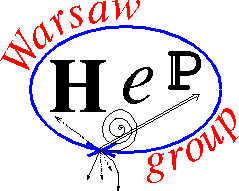SEMINARIUM FIZYKI WIELKICH ENERGII
Dnia 5 listopada (piątek) o godzinie 10:15, w sali B2.38 odbędzie się
seminarium, na którym zostanie wygłoszony referat pt.:
„Test of discrete symmetries with spin observables at J-PET.”
Referuje: mgr. Kamil Dulski
K. Dulski, A. Gajos, P. Moskal
Jagiellonian University, M. Smoluchowski Institute of Physics
Abstract:
The phenomenon of positron-electron annihilation is a subject-of-interest in many fields from medical imaging to fundamental studies. Two photon annihilation of positron-electron pair is already well established mode allowing for determination of annihilation position distribution, by means of Positron Emission Tomography (PET). However, a particularly interesting research object is the unique relationship that can bind a positron and an electron, that is called positronium. Positronium as the lightest purely leptonic bound state can serve as a sensitive probe of effects such as violation of discrete symmetries [1,2]. A particularly interesting case is testing the CPT invariance, a violation of which can be searched for as non-disappearing angular correlations between the photons from positronium annihilation and its spin. So far, attempts to experimentally investigate this effect have been limited mostly by the knowledge of the latter [2,3]. An improvement in the estimation of the spin direction was recently proposed by the Jagiellonian PET (J-PET) collaboration, introducing the J-PET detector as a new device which allows for the estimation of the positron spin axis along with the polarization of photons from positronium annihilation on an event-by-event basis [1,5,6]. So far, it is the only detector capable of such operation. The results of the most precise measurement of an angular correlation operator sensitive to violation of the combine symmetry under charge conjugation (C), parity (P) and time reversal (T) on the study of ortho-positronium (o-Ps) annihilations will be presented. The presented results do not indicate any violation at the level of the per mille [1], improving the previous measurements [2,3].
The new method of image reconstruction based on trilateration will be additionally presented [7]. It allows to determine the position of the o-Ps annihilation, which resulted in emission of three photons. Knowing the o-Ps annihilation position translated directly into the precision of estimating the o-Ps spin direction. The first reconstructed image of positron annihilation based on 3-photon o-Ps decays will be shown as a result from trilateration reconstruction [1]. Finally the world’s first positronium image of heart tissue from a patient will be presented [8]. The positronium image is a completely new imaging technique which is based on the determination of the mean positronium lifetime in each voxel. Resulting image allowed to distinguish the type of the tissue based on the mean positronium lifetime, which is not possible to distinguish by a conventional PET.
[1] P. Moskal et al., “Testing CPT symmetry in ortho-positronium decays with positronium
annihilation tomography”, Nat. Comm. 12 (2021) 5658
[2] W. Bernreuther et al., “How to test CP, T, and CPT invariance in the three photon decay of
polarized 3 S 1 positronium”, Z. Phys. C41 (1988) 143
[3] P. A. Vetter and S. J. Freedman, “Search for CPT-Odd Decays of Positronium“, Phys. Rev.
Lett. 91 (2003) 263401
[4] T. Yamazaki et al., “Search for CP Violation in Positronium Decay”, Phys. Rev. Lett. 104 (2010) 083401
[5] P. Moskal et al., „Synchronisation and calibration of the 24-modules J-PET prototype with 300 mm axial field of view”, IEEE Trans. Instrum. Measur. 70 (2021) 2000810
[6] S. Niedźwiecki et al., „J-PET: A New Technology for the Whole-body PET Imaging”, Acta Phys. Pol. B 48 (2017) 1567
[7] A. Gajos et al., “Trilateration-based reconstruction of ortho-positronium decays into three photons with the J-PET detector”, NIM A 819 (2016) 54
[8] P. Moskal et al., “Positronium imaging with the novel multiphoton PET scanner”, Sci. Adv. 7(2021) eabh4394
Serdecznie zapraszamy
dr hab. Katarzyna Grzelak
prof. dr hab. Jan Królikowski
prof. dr hab. Aleksander Filip Żarnecki
High Energy Physics Seminar (5 November 2021) · Indico (cern.ch)

